Maharam explores Alexander Girard’s creative legacy
Maharam celebrates the world of Alexander Girard through new collections of graphic upholstery fabrics, rugs and wallpapers designed between the 1950s and 1970s, and a short film exploring the American designer's relationship with New Mexico

The iconic American designer and architect Alexander Girard stands at the heart of a new capsule collection of reissued fabrics from the equally venerable textile house, Maharam. Released as part of its ‘Textiles of the 20th Century’ collection, the six reintroduced designs have been drawn from Girard’s tenure as founding design director of Herman Miller’s textile division, from the years 1952 to 1973, during which he created over 300 designs. Maharam’s eye-catching offering brings together some of the most enduring designs during that period, and will be available in two upholsteries, three wall coverings and one hand-woven rug.
Alexander Girard and Maharam’s ‘Textiles of the 20th Century’ collection

‘Mexidot’ collection
Girard’s inspiring ability to hone in on graphic patterns and create unusual combinations is put fully on display in Maharam’s new selection. No stranger to highlighting Girard’s brilliance – the ‘Textiles of the 20th Century’ collection already includes 30 Girard patterns to date – Maharam’s commitment to loyally reproducing these historic designs is matched by an underlying innovative spirit that keeps the design in step with current times. The company has even commissioned a short film for this occasion, highlighting the impact of Santa Fe and the surrounding New Mexico landscape on Girard’s life and work.
Specifically in the reproduction of ‘Mexidot’ (1963), an upholstery pattern that was originally released as part of a series of handwoven stripes called ‘Mexicotton’, Girard Studio (the entity run by the Girard family to promote and preserve Girard’s legacy) requested that the updated version be produced with reduced environmental impact and accessibility in mind. Maharam Design Studio has used recycled spun yarns to emulate the original look of natural cotton, while ensuring the textile still stands up to contemporary needs for high traffic seating.

Original sample books containing Herman Miller wallpaper and upholstery designed by Alexander Girard
Helmed by co-creative directors Alexander Kori Girard and Aleishall Girard Maxon, the designer’s grandchildren, Girard Studio states, ‘Sustainability and material quality have always been important considerations in the work we do with Maharam, but now more than ever we are striving to create products that enhance the built world around us while making minimal impact on the earth. This new collection is especially exciting in its use of postconsumer recycled and renewable materials.’ The three wallpaper designs: ‘Alphabet’ (1952), ‘Roman Stripe’ (1952), and ‘Broken Stripe’ (1952), have been digitally printed on non-PVC substrate, while retaining the warmth, tactility and vibrancy of the originals.
The collection is a testament to the timelessness of Girard’s aesthetic. ‘Pepitas’ (1952), an upholstery design featuring a pointed ellipsis formed by two intersecting discs of the same radius, which overlap so that the centre of one shape lies on the perimeter of the other, is an example of the staple designs that could be used in multiple applications, from drapery to wallpaper. Even the ‘Millerstripe’ rug, which is based on an upholstery textile designed in 1972 (and reissued by Maharam in 2002), celebrates the power of the universal stripe and is made from a wool twill that depicts the design’s original polychromatic layout at double its original scale.


Top, ‘Millerstripe’ rug. Above, ‘Pepitas’ upholstery fabric
‘The great thing about Girard’s designs is that with it all being from one hand, much of it works well together. I like that these designs reflect Girard’s belief that textiles are a fundamental building material for any space,’ says Maharam’s vice-president of design, Mary Murphy.
A Girard Studio statement concludes: ‘From an aesthetic perspective, we are thrilled to continue building awareness about the diversity in Girard’s vast stable of designs. Classic but unexpected at the same time, these upholsteries, wallcoverings, and rugs offer an understated but still distinctly Girard flavour.’
Wallpaper* Newsletter
Receive our daily digest of inspiration, escapism and design stories from around the world direct to your inbox.
Watch: Alexander Girard and New Mexico
Filmography: Alejandro Durán / Luma Projects


Top, ‘Alphabet’ wallpaper. Above, ‘Pepitas’ upholstery fabric
INFORMATION
Pei-Ru Keh is a former US Editor at Wallpaper*. Born and raised in Singapore, she has been a New Yorker since 2013. Pei-Ru held various titles at Wallpaper* between 2007 and 2023. She reports on design, tech, art, architecture, fashion, beauty and lifestyle happenings in the United States, both in print and digitally. Pei-Ru took a key role in championing diversity and representation within Wallpaper's content pillars, actively seeking out stories that reflect a wide range of perspectives. She lives in Brooklyn with her husband and two children, and is currently learning how to drive.
-
 Three new coffee makers for a contemporary brew, from a casual cup to a full-on branded espresso
Three new coffee makers for a contemporary brew, from a casual cup to a full-on branded espressoThree new coffee makers, from AeroPress, Jura and Porsche x La Marzocco, range from the defiantly manual to the bells and whistles of a traditional countertop espresso machine
By Jonathan Bell Published
-
 Don't miss Luxembourg's retro-futuristic lab pavilion in Venice
Don't miss Luxembourg's retro-futuristic lab pavilion in VeniceAs the Venice Biennale enters its last few weeks, catch 'A Comparative Dialogue Act' at the Luxembourg Pavilion
By Amah-Rose Abrams Published
-
 A Berlin park atop an office building offers a new model of urban landscaping
A Berlin park atop an office building offers a new model of urban landscapingA Berlin park and office space by Grüntuch Ernst Architeken offer a symbiotic relationship between urban design and green living materials
By Michael Webb Published
-
 Teruhiro Yanagihara's new textile for Kvadrat boasts a rhythmic design reimagining Japanese handsewing techniques
Teruhiro Yanagihara's new textile for Kvadrat boasts a rhythmic design reimagining Japanese handsewing techniques‘Ame’ designed by Teruhiro Yanagihara for Danish brand Kvadrat is its first ‘textile-to-textile’ product, made entirely of polyester recycled from fabric waste. The Japanese designer tells us more
By Danielle Demetriou Published
-
 First look: Western Mongolia meets Kew Gardens in John Pawson and Oyuna Tserendorj’s cashmere throws
First look: Western Mongolia meets Kew Gardens in John Pawson and Oyuna Tserendorj’s cashmere throwsArchitectural designer John Pawson and cashmere designer Oyuna Tserendor have collaborated on a cashmere throw collection inspired by Pawson’s 70m Lake Crossing in the Royal Botanical Gardens
By Scarlett Conlon Published
-
 Alcova to curate Heimtextil Trends 25/26: expect ‘inspiration and surprise’
Alcova to curate Heimtextil Trends 25/26: expect ‘inspiration and surprise’German textile fair Heimtextil has launched a new collaboration with Alcova, the experimental design platform. Here’s what to expect from the January 2025 fair
By Cristina Kiran Piotti Published
-
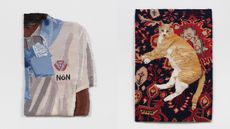 Sportswear logos, intimate portraits and a curled-up cat: Elizabeth Radcliffe’s beguiling tapestries go on show in New York
Sportswear logos, intimate portraits and a curled-up cat: Elizabeth Radcliffe’s beguiling tapestries go on show in New YorkAt Scottish artist Elizabeth Radcliffe's first US exhibition, a series exploring identity through branding is among works at Tribeca gallery Margot Samel
By Dan Howarth Published
-
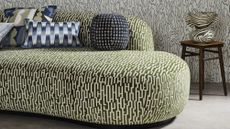 First look: clay meets paper and textiles in Henry Holland's new collection for Harlequin
First look: clay meets paper and textiles in Henry Holland's new collection for HarlequinHenry Holland, the fashion designer-turned-ceramicist, has teamed up with Harlequin for a range of playful, tactile wallpapers and textiles
By Hugo Macdonald Published
-
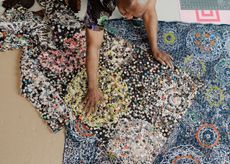 Nick Cave unveils vibrant textile collection inspired by his artworks
Nick Cave unveils vibrant textile collection inspired by his artworksAmerican artist Nick Cave’s vibrant creations have inspired an enchanting collection of home fabrics and wallcoverings for Knoll Textiles
By Pei-Ru Keh Last updated
-
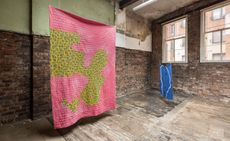 Cover stories: quilts inspired by architecture and design on show at Glasgow's Modern Institute
Cover stories: quilts inspired by architecture and design on show at Glasgow's Modern InstituteArrange Whatever Pieces Come Your Way creates unique, handmade covers inspired by art, architecture and apparel – now on view at The Modern Institute, Glasgow, until September 2022
By Rosa Bertoli Last updated
-
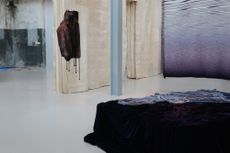 Buro Belén pushes material boundaries to enhance daily living
Buro Belén pushes material boundaries to enhance daily livingDutch designers Brecht Duijf and Lenneke Langenhuijsen of Buro Belén – named by Formafantasma as one of 25 creative leaders of the future in Wallpaper’s 25th Anniversary Issue ‘5x5’ project – explore materials and space
By Rosa Bertoli Last updated